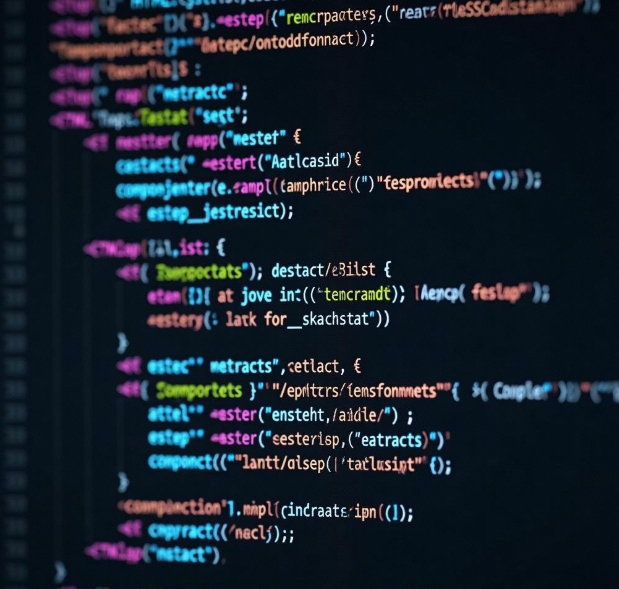Frontend Technologies for DApp Development: React, Vue, and Web3
- latest articles
- 1.DApp Development & Customization: Merging Diverse Market Needs with User Experience 2.Analysis of the Core Technical System in DApp Project Development 3.How to achieve cross-chain interoperability in Web3 projects? 4.How does the tokenization of points reconstruct the e-commerce ecosystem? 5.How to Set and Track Data Metrics for a Points Mall? 6.What is DApp Development? Core Concepts and Technical Analysis 7.Inventory of commonly used Web3 development tools and usage tips 8.Development of a Distribution System Integrated with Social E-commerce 9.Six Key Steps for Businesses to Build a Points Mall System 10.What is DApp Development? A Comprehensive Guide from Concept to Implementation
- Popular Articles
- 1.Future Trends and Technology Predictions for APP Development in 2025 2.Analysis of the DeFi Ecosystem: How Developers Can Participate in Decentralized Finance Innovation 3.From Zero to One: How PI Mall Revolutionizes the Traditional E-commerce Model 4.DAPP Development | Best Practices for Professional Customization and Rapid Launch 5.Recommended by the Web3 developer community: the most noteworthy forums and resources 6.From Cloud Computing to Computing Power Leasing: Building a Flexible and Scalable Computing Resource Platform 7.How to Develop a Successful Douyin Mini Program: Technical Architecture and Best Practices 8.Shared Bike System APP: The Convenient Choice in the Era of Smart Travel 9.How to Create a Successful Dating App: From Needs Analysis to User Experience Design 10.From Design to Development: The Complete Process of Bringing an APP Idea to Life
With the rapid development of blockchain technology, decentralized applications (DApps) are becoming a focal point for developers and users. As a crucial component of blockchain technology, DApps not only possess decentralized characteristics but also offer users more transparent, secure, and efficient services. Traditional web application development has gradually transitioned into the Web3 era, with new technologies and frameworks emerging continuously. Frontend frameworks like React and Vue play significant roles in DApp development. At the same time, Web3 technology is driving a revolution in frontend development. So, what are the applications and advantages of React, Vue, and Web3 in DApp development? This article will delve into how these three technologies collaborate in the development of decentralized applications, helping developers build efficient, user-friendly, and secure DApps.
I. React and DApp Development
React, an open-source frontend library developed and maintained by Facebook, has become a mainstream tool in modern frontend development due to its flexibility, component-based architecture, and efficient virtual DOM. For DApp developers, using React offers several advantages:
1. Componentization and Reusability
React's component-based nature is one of its most prominent advantages. In DApp development, frontend interfaces are often complex, requiring the display of various dynamic data and interactive components. Through React's component structure, developers can break down the application interface into multiple independent, reusable modules. For example, components such as user wallets, transaction records, and blockchain interaction interfaces can be developed separately and reused across different pages. This not only enhances code reusability but also improves team collaboration efficiency.
2. Reactivity and Virtual DOM
React achieves efficient DOM operations through its virtual DOM. When a DApp interacts with the blockchain, frontend pages often require frequent updates, such as refreshing account balances or transaction records after a transaction is completed. React efficiently updates the page by modifying only the necessary parts without re-rendering the entire page. This feature ensures a smooth user experience during blockchain interactions, particularly in addressing delays in blockchain transactions, as React provides users with seamless visual feedback.
3. Rich Ecosystem Support
React's widespread use has led to a rich ecosystem of support. In DApp development, React can seamlessly integrate with blockchain interaction libraries such as Web3.js and Ethers.js. These libraries enable developers to easily communicate with smart contracts, handle transactions, and retrieve block information through React. Additionally, React's state management tools (e.g., Redux, React Context) effectively manage global states in DApps, ensuring accurate data transmission and updates.
II. Vue and DApp Development
Vue is a lightweight frontend framework that has gradually secured its place in frontend development due to its simplicity, ease of learning, and flexibility. Unlike React, Vue's core design philosophy emphasizes usability and development efficiency, which also gives it certain advantages in DApp development.
1. Ease of Learning and Rapid Development
Vue has a relatively low learning curve, especially for developers with a foundation in HTML, CSS, and JavaScript. Vue provides a framework that is easy to understand and get started with. In DApp development, Vue's template syntax and directive system allow developers to build interfaces and interactions more effortlessly. Through Vue's two-way data binding, developers can efficiently manage application states and quickly build functionalities for interacting with smart contracts using concise syntax.
2. Componentization and Flexibility
Similar to React, Vue also supports component-based development, and its flexibility allows it to adapt to various development needs. In DApp development, Vue's component structure helps developers organize code more effectively. Whether creating transaction pages, querying balances, displaying blockchain data, or performing real-time updates, Vue's components can handle these tasks with ease. Additionally, Vue's state management tool, Vuex, provides great convenience for managing global states in DApps.
3. Integration with Web3.js
Vue also integrates seamlessly with blockchain interaction libraries. For example, Web3.js, the most commonly used library for interacting with the Ethereum blockchain, can be seamlessly integrated with Vue applications. Through Web3.js, Vue applications can easily implement functionalities such as wallet connections, transaction signing, and smart contract calls. Leveraging Vue's reactive features, developers can quickly respond to changes in blockchain data, displaying the latest transaction records, account balances, and other information.
III. Web3 Technology and DApp Development
Web3 technology refers to a series of decentralized protocols and tools that provide the underlying support for blockchain and smart contracts in DApps. Web3.js is one of the most commonly used frontend libraries, enabling frontend interactions with blockchain platforms like Ethereum. With the advent of the Web3 era, the integration of frontend technology and blockchain has become increasingly紧密.
1. Web3.js: The Bridge for Blockchain Interaction
Web3.js is a JavaScript library used to interact with the Ethereum blockchain. Developers can use Web3.js to send transactions, query blockchain states, and interact with smart contracts. In DApps, Web3.js typically serves as a bridge between the frontend and smart contracts, facilitating efficient communication between frontend applications and blockchain networks. Combined with React or Vue, Web3.js helps developers achieve real-time updates and interactive operations.
2. Ethereum Wallet Integration
DApp frontends often need to integrate with users' Ethereum wallets to facilitate transaction signing, account information queries, and more. Web3 technology enables frontend developers to easily integrate mainstream Ethereum wallets like MetaMask and WalletConnect. Through Web3.js, frontend applications can interact with these wallets to retrieve user account addresses, sign transactions, and perform other operations.
3. Smart Contract and Frontend Interaction
Smart contracts are the core of DApps, and frontend applications need to interact with them to execute specific logic. Through Web3.js, React and Vue can call smart contract methods to implement various functionalities such as transfers, voting, and lending. The transparency and immutability of smart contracts ensure the decentralized nature of DApps, while Web3 technology enables frontends to interact with these contracts conveniently.
IV. The Integration of React, Vue, and Web3
In practical DApp development, React, Vue, and Web3 technologies are not isolated; they typically work together in coordination. React and Vue, as frontend frameworks, manage user interfaces and interaction logic, while Web3, as a blockchain interaction library, handles communication with the blockchain. The two are connected through Web3.js, forming a complete frontend development solution for DApps.
1. Seamless Integration of Frontend and Blockchain
Both React and Vue can be deeply integrated with Web3.js, helping developers quickly implement blockchain interactions. Through Web3.js, React or Vue can monitor changes on the blockchain (such as transaction status) and update the interface in real time. This enables DApps to provide a more interactive experience, where users can see immediate feedback and enjoy a smooth user experience when conducting transactions or checking balances.
2. Data Management and State Synchronization
DApp frontends not only need to manage UI states within the application but also synchronize data from the blockchain in real time. Both React and Vue offer powerful state management tools (such as React's Context API and Vuex), which help developers manage data from the blockchain. By integrating with Web3.js, developers can synchronize blockchain data with the application's state, ensuring that the data displayed on the frontend is always up to date.
3. Enhancing Development Efficiency and User Experience
Both React and Vue are committed to improving development efficiency and user experience. In DApp development, developers can leverage the rapid development features of React and Vue, combined with the blockchain interaction capabilities of Web3.js, to build efficient and user-friendly decentralized applications. The introduction of Web3 technology endows DApps with true decentralization, ensuring the security and transparency of the applications.
V. Conclusion
React, Vue, and Web3 are key technologies in DApp development, each with distinct characteristics and advantages. Developers can choose the most suitable frontend framework based on project requirements, whether it's React's efficient and flexible component structure or Vue's simplicity and ease of learning. Meanwhile, Web3 technology, through libraries like Web3.js, enables frontends to easily interact with the blockchain, providing the core decentralized support for DApps. As blockchain technology continues to advance, React, Vue, and Web3 will continue to play important roles in future DApp development, driving the普及 and evolution of decentralized applications.
-

DApp Development & Customization: Merging Diverse Market Needs with User Experience
As blockchain technology matures and becomes more widespread, decentralized appl···
-

Analysis of the Core Technical System in DApp Project Development
With the rapid development of blockchain technology, decentralized applications ···
-

What is DApp Development? Core Concepts and Technical Analysis
With the rapid development of blockchain technology, decentralized applications ···

 Blockchain
Blockchain












